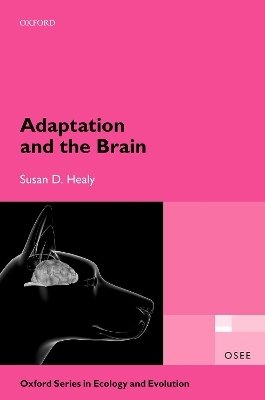
Adaptation and the Brain
Seiten
2021
Oxford University Press (Verlag)
978-0-19-954676-3 (ISBN)
Oxford University Press (Verlag)
978-0-19-954676-3 (ISBN)
Why does brain size vary so widely among vertebrate animal species? What role has natural selection played in shaping the structure and function of the vertebrate brain? This accessible book unravels the myriad adaptive explanations that have built up over decades, providing both a review and a critique of the work that has sought to explain which natural selection pressures have led to changes in brain size.
Debate over the causes of variation in brain size, especially within extant humans and during the course of hominid evolution, has persisted for at least a couple of centuries. However, it was not until relatively recently that there has been sufficient data to allow a coherent (and taxonomically widespread) evolutionary perspective to emerge. The comparative approach employed by evolutionary biologists and behavioural ecologists has been particularly enlightening with regard to addressing variation in brain size. However, the extent to which correlational data - currently generated in some profusion - can provide a suitable explanation is not yet clear, and a constructively critical analysis of the relevant data is now timely. Five classes of selection pressure have formed the majority of explanations: ecology, technology, innovation, sex, and sociality. The book starts with a brief description of the difficulties of measuring both brain size and intelligence (cognition), before addressing the evidence for each of these five factors in turn. It argues that although ecology currently provides the most convincing explanation for variation in the size of brain regions, none of the factors yet offers a robust and compelling explanation for variation in whole brain size. The book concludes by looking forwards, suggesting the future steps necessary to reach such an explanation; steps that are challenging but now within reach.
Adaptation and the Brain is suitable for graduate level students taking courses in animal behaviour and cognition, behavioural ecology, evolutionary ecology, psychology, and neuroscience as well as academics and professional researchers in these fields. The reader will not require a specific understanding of neuroscience, nor of the function of any particular brain region.
Debate over the causes of variation in brain size, especially within extant humans and during the course of hominid evolution, has persisted for at least a couple of centuries. However, it was not until relatively recently that there has been sufficient data to allow a coherent (and taxonomically widespread) evolutionary perspective to emerge. The comparative approach employed by evolutionary biologists and behavioural ecologists has been particularly enlightening with regard to addressing variation in brain size. However, the extent to which correlational data - currently generated in some profusion - can provide a suitable explanation is not yet clear, and a constructively critical analysis of the relevant data is now timely. Five classes of selection pressure have formed the majority of explanations: ecology, technology, innovation, sex, and sociality. The book starts with a brief description of the difficulties of measuring both brain size and intelligence (cognition), before addressing the evidence for each of these five factors in turn. It argues that although ecology currently provides the most convincing explanation for variation in the size of brain regions, none of the factors yet offers a robust and compelling explanation for variation in whole brain size. The book concludes by looking forwards, suggesting the future steps necessary to reach such an explanation; steps that are challenging but now within reach.
Adaptation and the Brain is suitable for graduate level students taking courses in animal behaviour and cognition, behavioural ecology, evolutionary ecology, psychology, and neuroscience as well as academics and professional researchers in these fields. The reader will not require a specific understanding of neuroscience, nor of the function of any particular brain region.
Susan D. Healy is a Research Professor at the School of Biology, University of St Andrews, Scotland, UK.
1: Introduction
2: The Measurable Brain
3: The Intelligent Brain
4: The Ecological Brain
5: The Innovative Brain
6: The Technical Brain
7: The Sexual Brain
8: The Social Brain
9: Conclusions
| Erscheinungsdatum | 13.03.2021 |
|---|---|
| Reihe/Serie | Oxford Series in Ecology and Evolution |
| Zusatzinfo | 19 colour line figures and illustrations and 5 tables |
| Verlagsort | Oxford |
| Sprache | englisch |
| Maße | 156 x 235 mm |
| Gewicht | 298 g |
| Themenwelt | Geisteswissenschaften ► Psychologie ► Biopsychologie / Neurowissenschaften |
| Naturwissenschaften ► Biologie ► Evolution | |
| Naturwissenschaften ► Biologie ► Zoologie | |
| ISBN-10 | 0-19-954676-2 / 0199546762 |
| ISBN-13 | 978-0-19-954676-3 / 9780199546763 |
| Zustand | Neuware |
| Informationen gemäß Produktsicherheitsverordnung (GPSR) | |
| Haben Sie eine Frage zum Produkt? |
Mehr entdecken
aus dem Bereich
aus dem Bereich
Grundlagen, Klinik, Rehabilitation
Buch | Softcover (2024)
Urban & Fischer in Elsevier (Verlag)
56,00 €
Buch | Spiralbindung (2022)
modernes lernen (Verlag)
29,95 €
im Kindes- und Erwachsenenalter
Buch | Softcover (2024)
MWV Medizinisch Wissenschaftliche Verlagsgesellschaft
59,95 €


